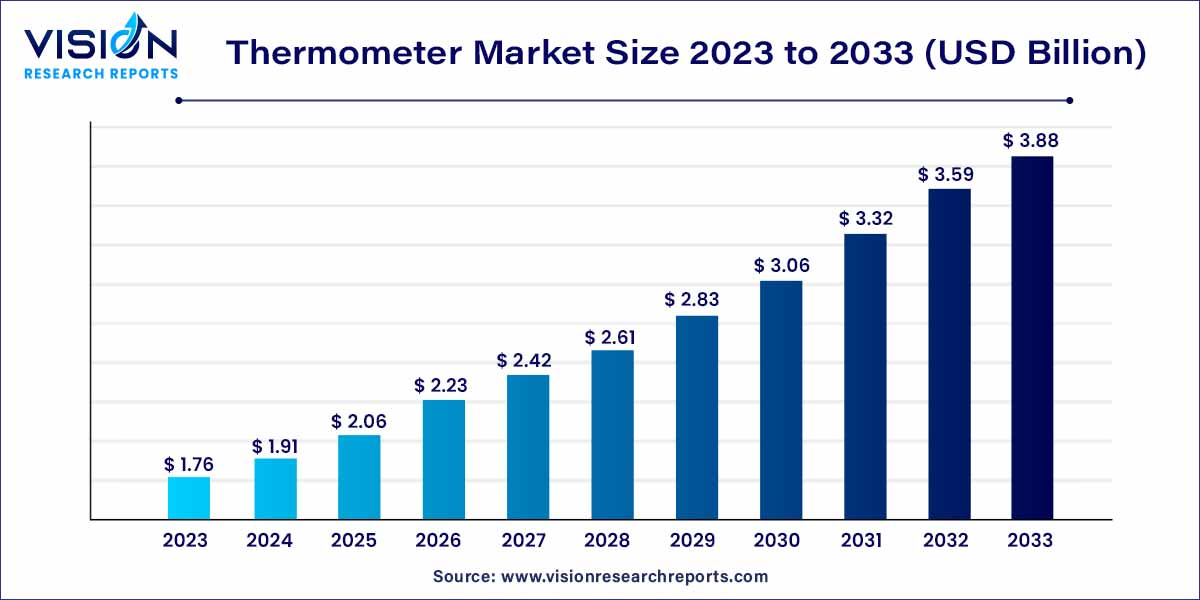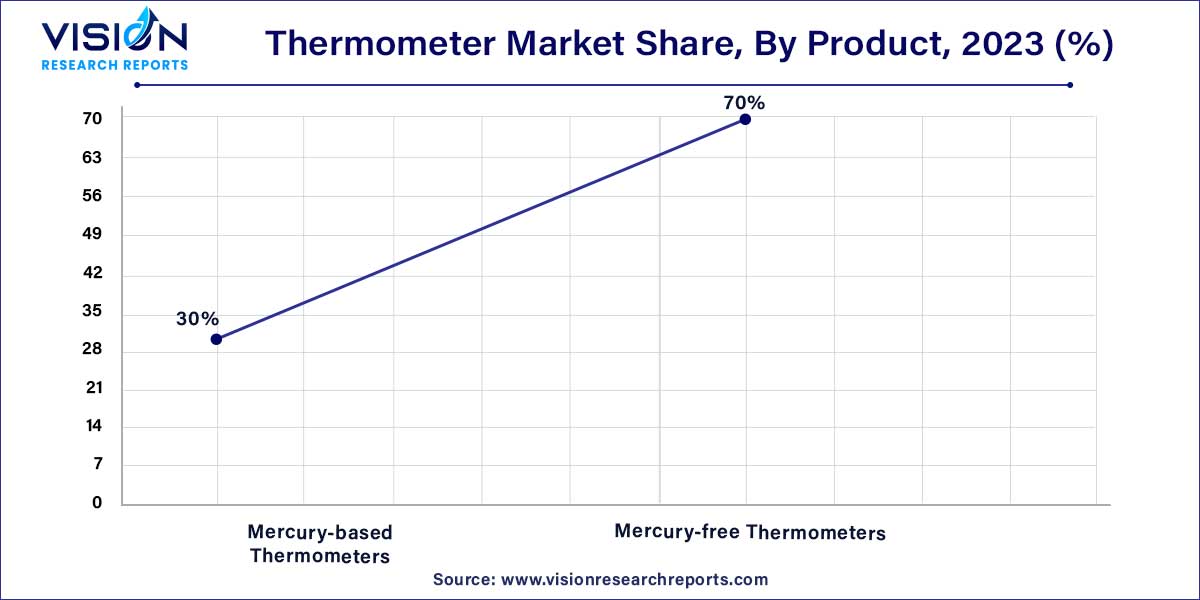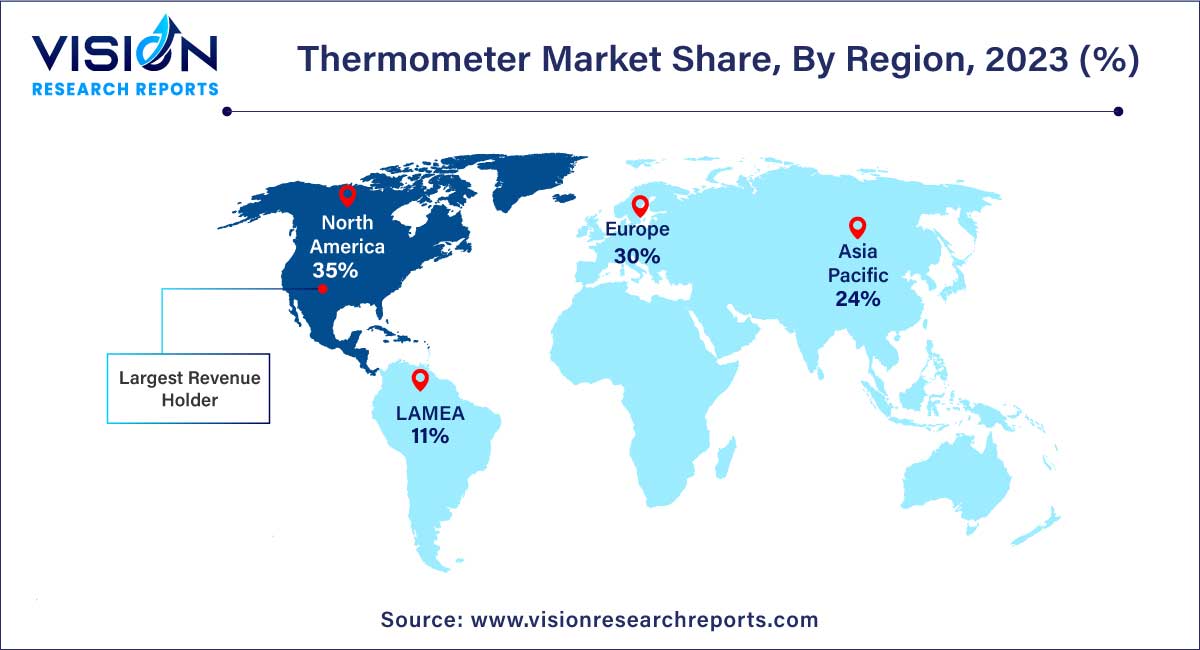The global thermometer market size was estimated at around USD 1.76 billion in 2023 and it is projected to hit around USD 3.88 billion by 2033, growing at a CAGR of 8.24% from 2024 to 2033. The thermometer market is driven by the rise in the prevalence of infectious diseases and medical conditions such as dengue and malaria as well as a surge in public awareness about the significance of body temperature monitoring.

The thermometer market is witnessing significant growth and innovation in recent years, driven by advancements in technology, increasing healthcare awareness, and the rising demand for accurate temperature measurement solutions across various industries. Thermometers have evolved beyond their traditional role in healthcare settings to encompass a diverse range of applications, including industrial, automotive, food processing, and meteorology, among others.
The growth of the thermometer market is propelled by various factors contributing to its expansion. Advancements in technology, particularly in sensor technology and wireless connectivity, have revolutionized thermometer design, enhancing their precision and functionality. Additionally, the increasing emphasis on healthcare awareness, particularly amidst global health crises, drives demand for accurate temperature monitoring solutions, boosting the adoption of digital thermometers for clinical and home use. Beyond healthcare, thermometers find diverse applications in industries such as manufacturing, food processing, and environmental monitoring, further driving market growth. Moreover, stringent food safety regulations and environmental monitoring initiatives contribute to the growing demand for thermometers in ensuring compliance and maintaining product quality. With continuous innovation and competition among manufacturers, the thermometer market is poised for sustained growth as stakeholders seek to meet evolving customer needs and explore new opportunities for market expansion.
In 2023, the mercury-free thermometers segment emerged as the leader in the market, capturing the largest revenue share at 70%. It is projected to maintain this position, exhibiting the fastest Compound Annual Growth Rate (CAGR) of 10.5% throughout the forecast period. This segment encompasses digital thermometers, infrared radiation thermometers, and other variants. The adoption of mercury-free thermometers, particularly infrared radiation thermometers and digital thermometers, is expected to surge significantly due to their ability to deliver more precise readings and their lack of association with the environmental hazards posed by mercury.

On the contrary, mercury-based thermometers are renowned for their user-friendliness and are commonly used in laboratory settings. However, since 2001, approximately 20 states have enforced bans on the use of mercury-based thermometers, particularly in medical applications, owing to the toxic effects of mercury. Anticipated stricter regulations regarding the utilization of these devices in various sectors are likely to further limit the prevalence of mercury-based thermometers. For example, Analytical Technology and Control Limited (ATCT) have announced their decision to cease supplying ASTM-approved mercury-based thermometers to customers, opting instead to provide spirit-filled thermometers as replacements
In 2023, the medical segment took the lead in the market, capturing the largest revenue share of 29%. This dominance can be attributed to the presence of well-established healthcare infrastructure and the high incidence of diseases necessitating body temperature assessment. A key driver of this segment's growth is the continual technological advancements in thermometers. For instance, A&D Company, Limited, has introduced the Instant Read Digital Ear thermometer, featuring one-button operation and 10 memory recalls, facilitating easy measurements in just one second with an LCD display.
The industrial segment is poised to experience a notable Compound Annual Growth Rate (CAGR) of 8.65% during the forecast period. This growth is anticipated due to the specific temperature maintenance requirements in industries such as pharmaceuticals, chemicals, and biotechnology throughout various stages of product development. Industrial thermometers are selected based on factors such as type, size, configurations, display options, features, applications, and operating environments. Additionally, the presence of key players like Microtemp Electrics Co., Ltd.; Endress+Hauser Management AG; and LumaSense Technologies, Inc. is expected to further bolster overall market growth in this segment. These factors collectively contribute to the anticipated growth of the industrial segment during the forecast period.
In 2023, North America emerged as the dominant force in the market, commanding a substantial revenue share of 35%. This supremacy can be attributed to factors such as the growing geriatric population and higher healthcare expenditure within the region. Additionally, healthcare camps and government initiatives aimed at raising awareness about infectious diseases and promoting better health practices are expected to further propel market growth.

Furthermore, the availability of technologically advanced products and the presence of major key players like 3M, Medline Industries, Welch Allyn, Inc., America Diagnostics Corporation, and A&D Medical are also significant contributors to the market's expansion in North America.
By Product
By Application
By Region
Chapter 1. Introduction
1.1. Research Objective
1.2. Scope of the Study
1.3. Definition
Chapter 2. Research Methodology
2.1. Research Approach
2.2. Data Sources
2.3. Assumptions & Limitations
Chapter 3. Executive Summary
3.1. Market Snapshot
Chapter 4. Market Variables and Scope
4.1. Introduction
4.2. Market Classification and Scope
4.3. Industry Value Chain Analysis
4.3.1. Raw Material Procurement Analysis
4.3.2. Sales and Distribution Channel Analysis
4.3.3. Downstream Buyer Analysis
Chapter 5. COVID 19 Impact on Thermometer Market
5.1. COVID-19 Landscape: Thermometer Industry Impact
5.2. COVID 19 - Impact Assessment for the Industry
5.3. COVID 19 Impact: Global Major Government Policy
5.4. Market Trends and Opportunities in the COVID-19 Landscape
Chapter 6. Market Dynamics Analysis and Trends
6.1. Market Dynamics
6.1.1. Market Drivers
6.1.2. Market Restraints
6.1.3. Market Opportunities
6.2. Porter’s Five Forces Analysis
6.2.1. Bargaining power of suppliers
6.2.2. Bargaining power of buyers
6.2.3. Threat of substitute
6.2.4. Threat of new entrants
6.2.5. Degree of competition
Chapter 7. Competitive Landscape
7.1.1. Company Market Share/Positioning Analysis
7.1.2. Key Strategies Adopted by Players
7.1.3. Vendor Landscape
7.1.3.1. List of Suppliers
7.1.3.2. List of Buyers
Chapter 8. Global Thermometer Market, By Product
8.1. Thermometer Market, by Product, 2024-2033
8.1.1. Mercury-based Thermometers
8.1.1.1. Market Revenue and Forecast (2021-2033)
8.1.2. Mercury-free Thermometers
8.1.2.1. Market Revenue and Forecast (2021-2033)
8.1.3. Infrared Radiation Thermometers
8.1.3.1. Market Revenue and Forecast (2021-2033)
8.1.4. Digital Thermometers
8.1.4.1. Market Revenue and Forecast (2021-2033)
8.1.5. Others
8.1.5.1. Market Revenue and Forecast (2021-2033)
Chapter 9. Global Thermometer Market, By Application
9.1. Thermometer Market, by Application, 2024-2033
9.1.1. Medical
9.1.1.1. Market Revenue and Forecast (2021-2033)
9.1.2. Industrial
9.1.2.1. Market Revenue and Forecast (2021-2033)
9.1.3. Food
9.1.3.1. Market Revenue and Forecast (2021-2033)
9.1.4. Laboratory
9.1.4.1. Market Revenue and Forecast (2021-2033)
9.1.5. Others
9.1.5.1. Market Revenue and Forecast (2021-2033)
Chapter 10. Global Thermometer Market, Regional Estimates and Trend Forecast
10.1. North America
10.1.1. Market Revenue and Forecast, by Product (2021-2033)
10.1.2. Market Revenue and Forecast, by Application (2021-2033)
10.1.3. U.S.
10.1.3.1. Market Revenue and Forecast, by Product (2021-2033)
10.1.3.2. Market Revenue and Forecast, by Application (2021-2033)
10.1.4. Rest of North America
10.1.4.1. Market Revenue and Forecast, by Product (2021-2033)
10.1.4.2. Market Revenue and Forecast, by Application (2021-2033)
10.2. Europe
10.2.1. Market Revenue and Forecast, by Product (2021-2033)
10.2.2. Market Revenue and Forecast, by Application (2021-2033)
10.2.3. UK
10.2.3.1. Market Revenue and Forecast, by Product (2021-2033)
10.2.3.2. Market Revenue and Forecast, by Application (2021-2033)
10.2.4. Germany
10.2.4.1. Market Revenue and Forecast, by Product (2021-2033)
10.2.4.2. Market Revenue and Forecast, by Application (2021-2033)
10.2.5. France
10.2.5.1. Market Revenue and Forecast, by Product (2021-2033)
10.2.5.2. Market Revenue and Forecast, by Application (2021-2033)
10.2.6. Rest of Europe
10.2.6.1. Market Revenue and Forecast, by Product (2021-2033)
10.2.6.2. Market Revenue and Forecast, by Application (2021-2033)
10.3. APAC
10.3.1. Market Revenue and Forecast, by Product (2021-2033)
10.3.2. Market Revenue and Forecast, by Application (2021-2033)
10.3.3. India
10.3.3.1. Market Revenue and Forecast, by Product (2021-2033)
10.3.3.2. Market Revenue and Forecast, by Application (2021-2033)
10.3.4. China
10.3.4.1. Market Revenue and Forecast, by Product (2021-2033)
10.3.4.2. Market Revenue and Forecast, by Application (2021-2033)
10.3.5. Japan
10.3.5.1. Market Revenue and Forecast, by Product (2021-2033)
10.3.5.2. Market Revenue and Forecast, by Application (2021-2033)
10.3.6. Rest of APAC
10.3.6.1. Market Revenue and Forecast, by Product (2021-2033)
10.3.6.2. Market Revenue and Forecast, by Application (2021-2033)
10.4. MEA
10.4.1. Market Revenue and Forecast, by Product (2021-2033)
10.4.2. Market Revenue and Forecast, by Application (2021-2033)
10.4.3. GCC
10.4.3.1. Market Revenue and Forecast, by Product (2021-2033)
10.4.3.2. Market Revenue and Forecast, by Application (2021-2033)
10.4.4. North Africa
10.4.4.1. Market Revenue and Forecast, by Product (2021-2033)
10.4.4.2. Market Revenue and Forecast, by Application (2021-2033)
10.4.5. South Africa
10.4.5.1. Market Revenue and Forecast, by Product (2021-2033)
10.4.5.2. Market Revenue and Forecast, by Application (2021-2033)
10.4.6. Rest of MEA
10.4.6.1. Market Revenue and Forecast, by Product (2021-2033)
10.4.6.2. Market Revenue and Forecast, by Application (2021-2033)
10.5. Latin America
10.5.1. Market Revenue and Forecast, by Product (2021-2033)
10.5.2. Market Revenue and Forecast, by Application (2021-2033)
10.5.3. Brazil
10.5.3.1. Market Revenue and Forecast, by Product (2021-2033)
10.5.3.2. Market Revenue and Forecast, by Application (2021-2033)
10.5.4. Rest of LATAM
10.5.4.1. Market Revenue and Forecast, by Product (2021-2033)
10.5.4.2. Market Revenue and Forecast, by Application (2021-2033)
Chapter 11. Company Profiles
11.1. Medline Industries, Inc.
11.1.1. Company Overview
11.1.2. Product Offerings
11.1.3. Financial Performance
11.1.4. Recent Initiatives
11.2. Welch Allyn
11.2.1. Company Overview
11.2.2. Product Offerings
11.2.3. Financial Performance
11.2.4. Recent Initiatives
11.3. Medtronic
11.3.1. Company Overview
11.3.2. Product Offerings
11.3.3. Financial Performance
11.3.4. Recent Initiatives
11.4. OMRON Corporation
11.4.1. Company Overview
11.4.2. Product Offerings
11.4.3. Financial Performance
11.4.4. LTE Scientific
11.5. America Diagnostics Corporation
11.5.1. Company Overview
11.5.2. Product Offerings
11.5.3. Financial Performance
11.5.4. Recent Initiatives
11.6. 3M Company
11.6.1. Company Overview
11.6.2. Product Offerings
11.6.3. Financial Performance
11.6.4. Recent Initiatives
11.7. Microlife Corporation
11.7.1. Company Overview
11.7.2. Product Offerings
11.7.3. Financial Performance
11.7.4. Recent Initiatives
11.8. Briggs Healthcare
11.8.1. Company Overview
11.8.2. Product Offerings
11.8.3. Financial Performance
11.8.4. Recent Initiatives
11.9. Exergen Corporation
11.9.1. Company Overview
11.9.2. Product Offerings
11.9.3. Financial Performance
11.9.4. Recent Initiatives
11.10. Terumo Corporation
11.10.1. Company Overview
11.10.2. Product Offerings
11.10.3. Financial Performance
11.10.4. Recent Initiatives
Chapter 12. Research Methodology
12.1. Primary Research
12.2. Secondary Research
12.3. Assumptions
Chapter 13. Appendix
13.1. About Us
13.2. Glossary of Terms
 Cross-segment Market Size and Analysis for
Mentioned Segments
Cross-segment Market Size and Analysis for
Mentioned Segments
 Additional Company Profiles (Upto 5 With No Cost)
Additional Company Profiles (Upto 5 With No Cost)
 Additional Countries (Apart From Mentioned Countries)
Additional Countries (Apart From Mentioned Countries)
 Country/Region-specific Report
Country/Region-specific Report
 Go To Market Strategy
Go To Market Strategy
 Region Specific Market Dynamics
Region Specific Market Dynamics Region Level Market Share
Region Level Market Share Import Export Analysis
Import Export Analysis Production Analysis
Production Analysis Others
Others